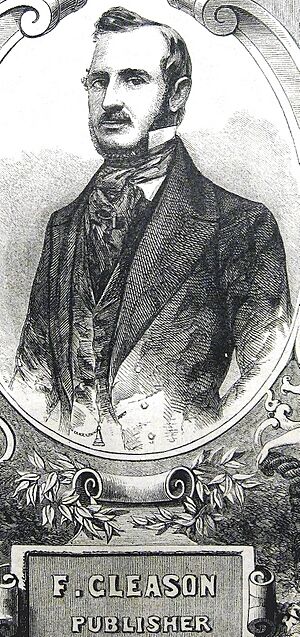Frederick Gleason facts for kids
Frederick Gleason (born around 1817, died November 6, 1896) was a well-known publisher in Boston, Massachusetts, in the mid-1800s. He is famous for creating Gleason's Pictorial. This was a very popular weekly magazine filled with pictures. At the time, it was a new and exciting idea in American publishing. Some people even called him "the father of illustrated journalism."
Contents
Frederick Gleason's Life Story
Early Years and First Publications
Frederick Gleason was born in Germany. He moved to the United States when he was young. He started his career by binding books in an office in Boston. In the late 1840s, Gleason began publishing many short novels. These books were often written by authors who wrote quickly for him. They sometimes used made-up names.
Some examples include books by "Harry Halyard" like The Doom of the Dolphin. These novels were usually 100 pages long. They focused on exciting stories and fast action. This style was similar to the early "dime novel" tradition.
Starting The Flag of Our Union
In 1846, Gleason launched a weekly story paper called The Flag of Our Union. This paper quickly became very popular. About 75,000 copies were sold each week! This success brought Gleason a lot of money. His publishing business grew and moved to different offices over the years. For a while, his main office was on Tremont Street in Boston.
Gleason's Summer Home, Belvidere
In the 1840s, Gleason built a summer house called "Belvidere". It was in West Roxbury, Massachusetts, near Franklin Park. The house was a beautiful mansion with lovely gardens. It had winding paths, fountains, and many old trees.
Pictures of Belvidere appeared in Gleason's Pictorial. The magazine described its amazing views of Boston Harbor. It also mentioned the surrounding plains and hills. The grounds were about three acres and had many different kinds of trees. The house was about four miles from the city of Boston. Gleason often hosted parties and guests at Belvidere.
In 1848, Gleason and his wife traveled to London, Berlin, and Paris. He came back to the U.S. with many new ideas for his business.
The Birth of Gleason's Pictorial
In 1851, Gleason and Maturin Murray Ballou started a new weekly paper. It was called Gleason's Pictorial Drawing-Room Companion. They based it on a famous British paper, the Illustrated London News. Gleason's Pictorial was an instant hit and made a lot of money.
In November 1854, Gleason sold his part of the Pictorial to Ballou. He said he had made enough money and wanted to "retire from business." Ballou then changed the paper's name to Ballou's Pictorial Drawing-Room Companion.
Competition and Later Ventures
The success of Gleason's Pictorial inspired many other publishers. Soon, new magazines like his appeared. An article in New York Daily Times in 1852 talked about this growing competition. It showed how popular pictorial magazines had become.
After Gleason's Pictorial, Gleason continued to publish other papers. These included Gleason's Literary Companion (from 1860 to 1870). He also published Gleason's Home Circle (from 1871 to 1890) and Gleason's Monthly Companion (from 1872 to 1887). He finally retired in 1890.
Gleason's money situation changed a lot over the years. In the 1850s, he earned high profits. But then, other publishers copied his ideas, which reduced his earnings. He also invested in the stock market. He sometimes made a lot of money quickly, but he also lost large amounts at other times.
Images for kids



